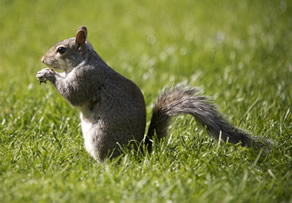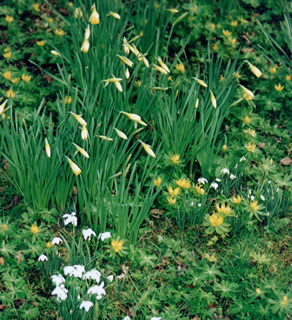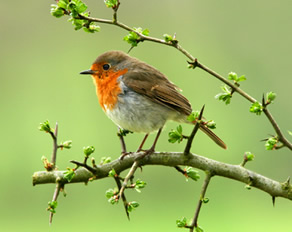The Grounds
When we moved to The Old Rectory in 2005, we were determined to make it a nicer place to live not only for ourselves, but also for the local wildlife-sometimes we find this frustrating when they eat our flowers or vegetables, but also it brings our guest and us a great deal of interest and pleasure. So this is what we have done so far:-
The Traditional Orchard
When we first moved to The Old Rectory, we started planting an Orchard in our one acre field. Whilst not perhaps as well known as the West Country as an apple growing area, Norfolk and Suffolk have a long history of making cider or as it is called locally 'cyder', which is made using a mixture of cooking and eating apples. Our orchard consists of over 150 trees grown on MM106 rootstock which means that they will grow to approximately 12 feet high making them fairly easy to pick. The orchard consists of apple, pear and plum trees – all of the apple varieties originate from Victorian times or earlier and many are local varieties such as St Edmund’s Russet. Lord Stradbroke, Norfolk Beefing and Adams Pearmain. We are growing the trees without the use of chemicals.
The Orchard now provides food and a home for wildlife as well as a source of fruit for our guests and us. During July, there is usually a good show of Bee Orchids & Pyramidal Orchids.
Our Wildlife Pond
In the Winter of 2009, we had a large wildlife pond dug – for once the fact that our soil is heavy clay played in to our hands as instead of the need for a pond liner, we were able to have it “puddled” - clay is the traditional and most eco friendly method of lining ponds. The clay was compacted on the inside of the empty pond to remove all the air spaces and to break down the structure. The pond is some 80 feet from side to side and has deep, shallow and boggy areas which we have planted so that it provides habitats, cover, food and perches for a wide range of creatures such as newts, dragonflies and house martins.
Hedges & Trees
As well as our orchard we have also planted a large number of Native trees – Oak, Silver Birch, Hazel, Ash, Beech and Hornbeam and Hedging such as Wild Cherry, Wild Pear, Blackthorn, Quickthorn, a Service Tree (one of the rarest native trees) and Field Maple. Much of the hedging has edible berries or fruit to provide the birds with food.
As well as the trees that we have planted we have also inherited some beautiful mature trees – Oak, Yew, Silver Birch and a magnificent 85 foot Horse Chestnut. We have under-planted these with bulbs such as Aconites and Snowdrops.
With the increase in the number of trees, we have used the branches we have pruned to make several dead hedges at The Old Rectory.
Dead hedges are piles of branches and twigs arranged to form a barrier which are increasingly used as a way to dispose of the material that arises from thinning and pruning trees. Using surplus branches in this way is good for wildlife - especially for small mammals and birds - because it gives them somewhere to shelter that is protected from predators and from the wind and rain as well as providing a rich feeding ground. It also creates a habitat for insects and beetles. An added advantage is that dead hedges can offer more instant wildlife cover than a newly planted conventional hedge.
We use all the woody pruning’s to create the dead hedge & although it takes a while to decompose, as the branches aren't touching the ground, we top the hedge-up as it starts to reduce in bulk.
Dead hedges are preferable to the alternative - a smelly bonfire!
Wildflowers
We are beginning to develop an area of the field as a wildflower area and in our field & orchard we try to follow a mowing programme that is sympathetic to plants & wildlife.
The native flowers & grasses in the field include Birds Foot Trefoil,Black Knapweed, Bladder Campion, Common Knapweed, Greater Knapwood, Black Meddick, Common Vetch, Cowslip, Field Scabious, Hemp Agrimony, Ladies Bedstraw, Meadow Buttercup, Musk Mallow, Ox-Eye Daisy, Ribwort Plantain, Red Campion, Wild Red Clover, Rough Hawkbit, Sainfoin, Self Heal, Small Scabious, Tufted Vetch, Red Campion, White Campion, Wild Carrot, Wild Marjoram, Yarrow, Yellow Rattle
As for Grasses-Meadow Fecue, Smooth Stalked Meadow Grass, Crested Dogstail, Sheeps Fescue, Red Fescue, Browntop Bentgrass, Hard Fescue, Chewings Fescue can all be found
What animals & birds might you see during your stay at The Old Rectory?
The deer often enjoy a drink and a paddle in our pond.
All of the following are seen quite often at The Old Rectory – A Barn Owl, Muntjac Deer, rabbits (in abundance!),Squirrels, and many birds including Thrushes, Blackbirds, Swallows, 2 types of Woodpecker, Swifts, House Martins, Robins, Treecreepers, Chaffinch, Rooks, Dunnocks, Tits, Finches, Pheasants & Buzzards.
Moths & Bats
We were pleased to welcome Joan & Keith as guests in one of our cottages in the Summer of 2018. The couple who come from Norfolk have a great interest in Moths and asked if they could use an Actinic Light to see what moths they could attract. This was a first for The Old Rectory and Joan & Keith and we were delighted with the outcome- 604 moths with over a 100 different species of moths of all sizes and bearing such exotic names as Yellow-barred Longhorn, Hoary Bell, Pebble Hook Tip and Snout.
Fortunately, only one Codling (the scourge of apple & pear trees and therefore a great danger to the 150 odd trees in our orchard!) was spotted.
Whilst we thought this was a great result, we felt just slightly deflated when Joan told us that there had been over 1800 different species of moth identified in Suffolk since Victorian times-never the less it was a good start!
View a list of which moth & bat species were found.
During their stay, they also identified 4 species of bats – the Common Pipistrelle, along with Soprano Pipistrelle, Natterer’s, and Barbastelle.










